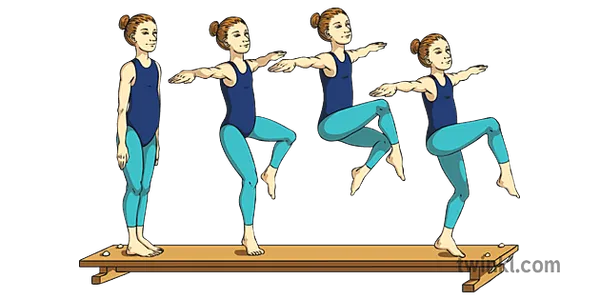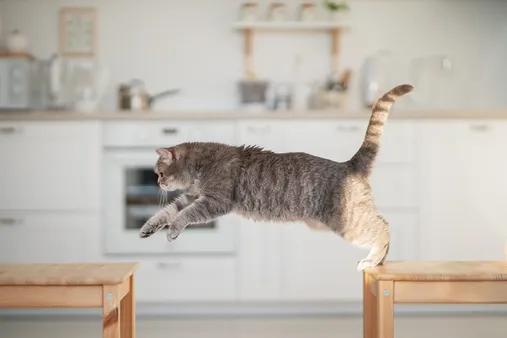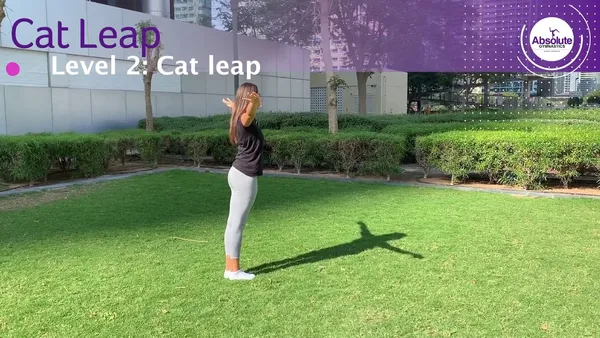Table of Contents
Welcome to Kizworld's ultimate guide to cat leaps, an exhilarating fusion of strength, agility, and grace. Whether you're a seasoned athlete seeking new challenges or a fitness enthusiast yearning to elevate your routine, this comprehensive resource will equip you with the knowledge and techniques to master this dynamic movement. Discover the benefits of cat leaps, delve into a step-by-step guide with detailed instructions, explore variations to push your limits, and uncover common mistakes to avoid. Unleash your inner athlete and soar to new heights with kizworld's guidance on How to do a cat leap.
How to do a Cat Leap: A Guide to Mastering the Feline Art of Jumping
I. Cat Leap: Step-by-Step Guide to Conquering This Gymnastics Move
Cat Leap: Step-by-Step Guide to Conquering This Gymnastics Move
1. Warm Up
Before attempting a cat leap, it's crucial to warm up your body to prevent injuries. Start with some light cardio exercises, such as jogging or jumping jacks, to get your heart rate up. Then, stretch your muscles, focusing on your legs, back, and shoulders. You can find a detailed guide on warming up for gymnastics here.
2. Find a Suitable Location
Choose a safe and open area to practice your cat leap. A gymnastics mat or a soft grassy area would be ideal. Make sure there are no obstacles or hazards in the vicinity that could cause injury.
3. Position Yourself
Stand with your feet shoulder-width apart and your toes pointed forward. Bend your knees slightly and keep your back straight. Your arms should be at your sides, with your palms facing forward.
4. Bend Your Knees and Swing Your Arms
In one swift motion, bend your knees and swing your arms backward. As you do this, jump up into the air, reaching your arms overhead.
5. Land Softly
As you land, bend your knees and absorb the impact with your legs. Keep your back straight and your head up. Aim to land softly on the balls of your feet.
| Tip | Description |
Choose a Safe Location | Select a safe and open area with no obstacles or hazards. |
Wear Proper Clothing and Footwear | Wear comfortable and supportive clothing and shoes. |
Warm Up Properly | Perform light cardio and stretching exercises before attempting the cat leap. |
Start Slowly and Gradually Increase the Height of Your Jumps | Begin with small jumps and gradually increase the height as you gain confidence. |
Listen to Your Body and Take Breaks When Needed | Pay attention to your body's signals and rest when necessary. |
Variations of the Cat Leap
Once you've mastered the basic cat leap, you can try some variations to challenge yourself.
- Tuck Jump: In a tuck jump, you bring your knees to your chest as you jump, tucking your arms in front of you.
- Straddle Jump: In a straddle jump, you jump with your legs spread apart and your arms extended to the sides.
- Frog Jump: In a frog jump, you jump with your legs bent and your feet turned outward, resembling a frog's legs.
Common Mistakes to Avoid When Doing a Cat Leap
Here are some common mistakes to avoid when performing a cat leap:
- Not Warming Up Properly: Failing to warm up can increase the risk of injury.
- Jumping from Too High a Height: Start with small jumps and gradually increase the height as you gain confidence.
- Not Landing Softly: Landing with stiff legs or flat feet can cause injuries.
- Not Wearing Proper Clothing and Footwear: Wearing inappropriate clothing or shoes can hinder your performance and increase the risk of injury.
- Ignoring Pain or Discomfort: If you experience pain or discomfort, stop immediately and consult a healthcare professional.
With practice and dedication, you'll be able to master the cat leap and enjoy the thrill of this dynamic gymnastics move.
If you're interested in learning more about gymnastics, check out our comprehensive guide to the benefits of gymnastics for kids. You can also find tips on choosing the right gymnastics leotard and mastering the basic gymnastics skills on our website.
II. Mastering the Proper Form and Techniques for a Safe and Powerful Cat Leap
Mastering the Proper Form and Techniques for a Safe and Powerful Cat Leap
1. Warm Up Properly
Before attempting a cat leap, it's crucial to warm up your muscles to prevent injuries. Start with light cardio exercises like jogging or jumping jacks to get your blood flowing. Then, perform dynamic stretches that target the muscles involved in the cat leap, such as your quads, hamstrings, and calves. Read more about improving flexibility and mobility with gymnastics.
2. Choose a Suitable Location
Select a safe and open area with a soft landing surface, such as a grassy field or a gym mat. Avoid performing cat leaps on hard surfaces like concrete or asphalt, as they can increase the risk of injury.
3. Position Yourself
Stand with your feet shoulder-width apart and your toes pointed forward. Bend your knees slightly and keep your back straight. Your arms should be at your sides, with your elbows slightly bent.
4. Bend Your Knees and Swing Your Arms
As you prepare to jump, bend your knees and swing your arms back. This will help you generate power for the leap. As you swing your arms forward, push off the ground with your feet and jump as high as you can.
5. Land Softly
When you land, bend your knees and absorb the impact with your legs. Keep your back straight and your head up. Avoid landing on your heels, as this can put excessive stress on your joints.
Mistake | How to Avoid |
Not Warming Up Properly | Always warm up your muscles before attempting a cat leap to prevent injuries. |
Jumping from Too High a Height | Start with a lower height and gradually increase it as you become more comfortable with the movement. |
Not Landing Softly | Bend your knees and absorb the impact with your legs when landing to avoid putting excessive stress on your joints. |
Not Wearing Proper Clothing and Footwear | Wear comfortable and supportive clothing and footwear to ensure safety and prevent injuries. |
Ignoring Pain or Discomfort | If you experience pain or discomfort during a cat leap, stop immediately and consult a healthcare professional. |
By following these steps and avoiding common mistakes, you can master the proper form and techniques for a safe and powerful cat leap. With practice and dedication, you'll be able to perform this dynamic movement with confidence and grace.
- Discover the benefits of gymnastics for kids.
- Explore the best gymnastics equipment for home use.
- Learn how to choose the right gymnastics leotard.
III. Essential Preparatory Exercises to Build Strength and Flexibility for Cat Leaps
Essential Preparatory Exercises to Build Strength and Flexibility for Cat Leaps
To master the cat leap, it's crucial to build a solid foundation of strength and flexibility. Here are some essential preparatory exercises to enhance your performance:
1. Squats
Squats are a fundamental exercise that targets the muscles used in the cat leap. They help strengthen your legs, glutes, and core, providing a strong base for jumping.
- Stand with your feet shoulder-width apart, toes slightly turned out.
- Bend your knees and lower your body as if sitting back into a chair.
- Keep your chest up and your back straight.
- Lower until your thighs are parallel to the ground.
- Press through your heels and return to the starting position.
2. Lunges
Lunges work your quads, hamstrings, and glutes, improving your balance and coordination. They also help strengthen the muscles that stabilize your knees.
- Step forward with one leg and bend your knee so that your thigh is parallel to the ground.
- Keep your other leg straight and your heel on the ground.
- Lower your body until your front knee is at a 90-degree angle.
- Press through your front heel and return to the starting position.
- Repeat with the other leg.
3. Push-Ups
Push-ups strengthen your upper body, particularly your chest, triceps, and shoulders. This strength is essential for propelling yourself forward during the cat leap.
- Start in a plank position with your hands shoulder-width apart.
- Bend your elbows and lower your body until your chest is almost touching the ground.
- Press through your hands and return to the starting position.
- Keep your body straight and your core engaged throughout the movement.
4. Rows
Rows target your back muscles, which play a crucial role in stabilizing your body during the cat leap. They also help improve your posture and reduce the risk of injury.
- Hold a dumbbell or resistance band in each hand.
- Bend your knees slightly and hinge forward at your hips, keeping your back straight.
- Pull the weights or band towards your chest, squeezing your shoulder blades together.
- Slowly lower the weights or band back to the starting position.
5. Calf Raises
Calf raises strengthen your calf muscles, which are essential for generating power during the cat leap. Strong calves also help improve your balance and stability.
- Stand with your feet shoulder-width apart.
- Slowly raise up onto your toes, lifting your heels off the ground.
- Hold the position for a few seconds, then slowly lower your heels back down.
- Repeat for several repetitions.
By incorporating these preparatory exercises into your routine, you can build the strength and flexibility needed to perform cat leaps safely and effectively. Remember to warm up before each workout and cool down afterward to prevent injuries.
For more exercises to improve your cat leap, check out our article on How to Do a Cat Leap.
IV. Common Mistakes to Avoid and Tips for Improving Cat Leap Technique
Common Mistakes to Avoid and Tips for Improving Cat Leap Technique
Common Mistakes to Avoid
- Not Warming Up Properly: Warming up properly is crucial to prevent injuries and prepare your body for the explosive movement of the cat leap. Always begin with a few minutes of light cardio, dynamic stretching, and activation exercises to get your muscles and joints ready.
- Jumping from Too High a Height: Start with a comfortable height and gradually increase it as you gain confidence and skill. Attempting to jump from too high a height too early can lead to injuries or discourage you from continuing the exercise.
- Not Landing Softly: Landing softly is essential to minimize the impact on your joints and reduce the risk of injuries. Bend your knees and roll your feet onto the ground to absorb the shock, rather than landing stiffly.
- Not Wearing Proper Clothing and Footwear: Wear comfortable and flexible clothing that allows for a full range of motion. Choose athletic shoes with good cushioning and support to provide stability during the landing.
- Ignoring Pain or Discomfort: Never ignore pain or discomfort while performing the cat leap. If you experience any pain, stop immediately and consult a healthcare professional to rule out any injuries or underlying conditions.
Tips for Improving Cat Leap Technique
- Choose a Safe Location: Select a safe and suitable location for practicing the cat leap, such as a gym with a padded floor or a soft grass area.
- Start Slowly and Gradually Increase the Height of Your Jumps: Begin with a comfortable height and gradually increase it as you become more confident and skilled. This will help you build strength, coordination, and control.
- Strengthen Your Core and Leg Muscles: Engage your core muscles throughout the movement to stabilize your body and maintain proper form. Additionally, focus on strengthening your leg muscles, especially the quadriceps, hamstrings, and glutes, to generate explosive power for the jump.
- Practice Good Form: Pay attention to your body alignment during the cat leap. Keep your back straight, chest up, and core engaged. Drive your arms and legs simultaneously and land softly with your knees bent.
- Listen to Your Body and Take Breaks When Needed: Listen to your body and take breaks when you need them. Avoid pushing yourself too hard, as this can lead to injuries or burnout. Rest adequately between sets to allow your muscles to recover.
Exercise | Sets | Reps | Rest |
Bodyweight Squats | 3 | 10-12 | 30 seconds |
Lunges | 3 | 8-10 per leg | 30 seconds |
Calf Raises | 3 | 15-20 | 30 seconds |
Core Planks | 3 | 30-60 seconds hold | 30 seconds |
Jumping Jacks | 3 | 20-30 | 30 seconds |
Tip: Incorporate the cat leap into your workout routine as a dynamic exercise to improve your overall athleticism and power.
How to Improve Your Flexibility and Mobility with Gymnastics
V. Conclusion
As you embark on your cat leap journey, remember to prioritize safety and listen to your body. Start slowly and gradually increase the height of your jumps as you gain confidence and strength. With dedication and practice, you'll master this exhilarating movement and unlock new levels of athleticism. Embrace the challenge, embrace the thrill, and let the cat leap become a testament to your boundless potential.